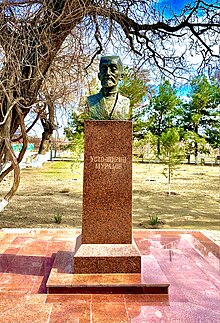Usta Shirin Murodov (was born on August 18, 1879, Bukhara, Bukhara Emirate – December 2, 1957, Tashkent, Uzbek SSR, USSR) was a Soviet Uzbek master artist – a painter, pottery craftsman, and folklorist. He was an honorary member of the Academy of Sciences of Uzbekistan SSR (1943) and a distinguished artist recognized for his contributions to the art in the Uzbek SSR (1943). He was also the recipient of the Stalin Prize in the first class (1948).
Usta Shirin Murodov | |
|---|---|
| Born | August 18, 1879 |
| Died | February 12, 1957 (aged 77) |
| Nationality | Uzbek |
| Style | Ornament (art), ganch carving |
| Awards |
|

Biography
editShirin learned his craft from his father, Master Murod, and his grandfather, Master Nosir.[2][5] He started practicing art from a young age and learned the skill from his family.[6] As an independent artist, he participated in the decoration of the Karmana Palace of the Emir of Bukhara and the White Hall of the Sitorai Mokhi-Khosa summer palace, where he gained recognition.[6][1][5][2][7] In his artistic creations, Shirin was particularly known for his pottery craftsmanship. He used traditional patterns and shapes in new and innovative ways and the ganch technology he created was also used in the renovation of the Romanov Palace.[8] In his early work, he used pottery as a canvas for his artwork, creating stunning and intricate pottery pieces[5]
Usta Shirin also decorated many clubs, public buildings, and memorial structures with his pottery works. He adorned various venues, including the Uzbek SSR Pavilion at the All-Union Agricultural Exhibition, the pavilions of the Turkmenistan SSR (1938), the Tashkent Circus, the Navoi Theater (Bukhara Hall), the Muqimi Theater, the Alisher Navoi Literary Museum, and others.[6][5][1][9][2] He also contributed to the restoration of historical monuments such as the ruined part of the Samanid Mausoleum, the Mir Arab Madrasa, the Abdulaziz Khan Madrasa domes, and the minarets in front of the Magoki Attori Mosque.[5][10][2]
Usta Shirin passed away on 12 February 1957, and was buried in the Chigatoy cemetery in Tashkent.[5][1][11]
Awards
edit- Stalin Prize 1st class (1948)[3]
- Honored Artist of the Uzbek SSR (1943)[1][7][2][3]
- Order of Lenin[11]
- Order of the Red Banner of Labor[11]
- various other medals[3][4]
- Honorary Member of the Academy of Sciences of the Uzbek SSR (1943)[7][3]
- Order of Outstanding Merit (22 August 2001)[12]
See also
editReferences
edit- ^ a b c d e "Мурадов Ширин (Уста Ширин)". tashkentpamyat.ru. Retrieved 2023-10-27.
- ^ a b c d e f "Усто Ширин Мурадов — 142 года со дня рождения". mytashkent.uz. Retrieved 2023-10-27.
- ^ a b c d e "Usta Shirin Murodov". arboblar.uz. Retrieved 2023-10-27.
- ^ a b "Летний дворец эмира Бухарского. Уста Ширин Мурадов. Buxoro amirining yozgi saroyi, Ismoil Somoniy maqbarasi va Chashma-Ayub". nefer.livejournal.com. Retrieved 2023-10-28.
- ^ a b c d e f "Oʻzbekistonda xizmat koʻrsatgan sanʼat arbobi Usta Shirin Murodov 1879-yil 18 avgust tavallud topgan kun.1879-08-18". taqvim.uz. Retrieved 2023-10-28.
- ^ a b c ""Durdonalar" loyihasida ganchkor, xalq amaliy san'ati ustasi Usta Shirin Murodov hayoti va faoliyati haqida so'z yuritamiz". handicraftman.uz. Retrieved 2023-10-28.
- ^ a b c "Мурадов Ширин". www.art-drawing.ru. Retrieved 2023-10-27.
- ^ ""Севимли Тошкент шаҳрига": Буюк князь Николай Константинович саройи яна музейга айланади ва ташриф буюрувчилар учун очиқ бўлади". anhor.uz. Retrieved 2023-11-08.
- ^ "Urush san'ati: Markaziy Osiyo". www.caa-network.org. Retrieved 2023-10-28.
- ^ "Abdulazizxon madrasasi". uzheritage.org. Retrieved 2023-10-27.
- ^ a b c "Уста Ширин Муродов". Qizil Oʻzbekiston (in Uzbek). No. 38. 13 February 1957. p. 3.
- ^ "Указ Президента Республики Узбекистан О награждении посмертно мастеров литературы и искусства, внесших огромный вклад в развитие узбекской национальной культуры". Narodnoe slovo (in Russian). No. 165. 23 August 2001. p. 1.